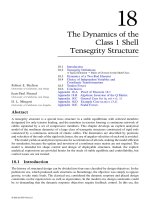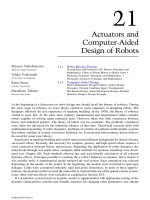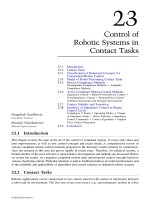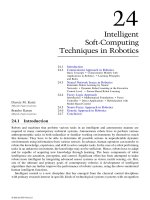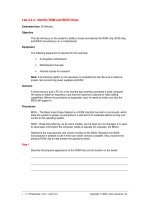Tài liệu Modeling, Measurement and Control P28 docx
Bạn đang xem bản rút gọn của tài liệu. Xem và tải ngay bản đầy đủ của tài liệu tại đây (3.76 MB, 15 trang )
28
Present State and Future
Trends in Mechanical
Systems Design for
Robot Application
28.1 Introduction
28.2 Industrial Robots
Definition and Applications of Industrial Robots • Robot
Kinematic Design • Industrial Robot Application
28.3 Service Robots
From Industrial Robots to Service Robots • Examples of
Service Robot Systems • Case Study: A Robot System
for Automatic Refueling
28.1 Introduction
In 1999 some 940,000 industrial robots were at work and major industrial countries reported growth
rates in robot installation of more than 20% compared to the previous year (see Figure 28.1) The
automotive, electric, and electronic industries have been the largest robot users; the predominant
applications are welding, assembly, material handling, and dispensing. The flexibility and versatility
of industrial robot technology have been strongly driven by the needs of these industries, which
account for more than 75% of the world’s installation numbers. Still, the motor vehicle industry
accounts for some 50% of the total robot investment worldwide.
9
Robots are now mature products facing enormous competition by international manufacturers
and falling unit costs. A complete six-axis robot with a load capacity of 10 kg was offered at less
than $60,000 in 1999. It should be noted that the unit price only accounts for about 30% of the
total system cost. However, for many standard applications in welding, assembly, palletizing, and
packaging, preconfigured, highly flexible workcells are offered by robot manufacturers, thus pro-
viding cost effective automation to small and medium sized operations.
A broad spectrum of routine job functions led to a robotics renaissance and the appearance of
service robots. Modern information and telecommunication technologies have had a tremendous
impact on exploiting productivity and profitability potentials in administrative, communicative, and
consultative services. Many transportation, handling, and machining tasks are now automated.
Examples of diverse application fields for robots include cleaning, inspection, disaster control,
waste sorting, and transportation of goods in offices or hospitals. It is widely accepted that service
robots can contribute significantly to better working conditions, improved quality, profitability, and
availability of services. Statistics on the use and distribution of service robots are scarce and
incomplete. Based on sales figures from leading manufacturers, the total service robot stock can
Martin Hägele
Fraunhofer Institute
Rolf Dieter Schraft
Fraunhofer Institute
© 2002 by CRC Press LLC
be estimated at a few thousand and certainly below 10,000 units. It is expected that within ten
years, service robots may become commodities and surpass industrial robot applications.
Robots are representative of mechatronics devices which integrate aspects of manipulation,
sensing, control, and communication. Rarely have so many technologies and scientific disciplines
focused on the functionality and performance of a system as they have done in the fields of robot
development and application. Robotics integrates the states of the art of many front-running
technologies as depicted in Figure 28.2.
This chapter will give an overview of the state of the art and current trends in robot design and
application. Industrial and service robots will be considered and typical examples of their system
design will be presented in two case studies.
28.2 Industrial Robots
28.2.1 Definition and Applications of Industrial Robots
Large efforts have been made to define an industrial robot and to classify its application by industrial
branches so that remarkably precise data and monitoring are available today.
9
According to ISO
8373, a manipulating industrial robot is defined as:
FIGURE 28.1
Yearly installations and operational stock of industrial robots worldwide.
FIGURE 28.2
Robotics and mechatronics. (From Warnecke, H.-J. et al., in
Handbook of Industrial Robotics,
1999,
p. 42. Reprinted with permission of John Wiley & Sons.)
© 2002 by CRC Press LLC
An automatically controlled, reprogrammable, multipurpose manipulator programmable in three
or more axes (in three or more degrees of freedom, DOF), which may be either fixed in place
or mobile for use in industrial automation applications.
The terms used in the definition above are:
• Reprogrammable: a device whose programmed motions or auxiliary functions may be
changed without physical alterations.
• Multipurpose: capable of being adapted to a different application with physical alterations.
• Physical alterations: alterations of the mechanical structure or control system except for
changing programming cassettes, ROMs, etc.
• Axis: direction used to specify motion in a linear or rotary mode.
A large variety of robot designs evolved from specific task requirements (see Figure 28.3). The
specialization of robot designs had a direct impact on robot specifications and its general appearance.
The number of multipurpose or universal robot designs was overwhelming. However, many appli-
cations are common enough that robot designs with specific process requirements emerged. Exam-
ples of the different designs and their specific requirements are shown in Figure 28.4.
28.2.2 Robot Kinematic Design
The task of an industrial robot in general is to move a body (workpiece or tool) with six maximal
Cartesian spatial DOF (three translations, three rotations) to another point and orientation within
a workspace. The complexity of the task determines the required kinematic configuration. The
number of DOFs determines how many independently driven and controlled axes are needed to
move a body in a defined way. In the kinematic description of a robot, we distinguish between:
• Arm: an interconnected set of links and powered joints that support or move a wrist, a hand
or an end effector.
• Wrist: a set of joints between the arm and the hand that allows the hand to be oriented to
the workpiece. The wrist is for orientation and small changes in position.
FIGURE 28.3
Examples of specialization of robot designs. (Courtesy of Reis Robotics, ABB Flexible Automation,
and CMB Automation. From Warnecke, H.-J. et al., in
Handbook of Industrial Robotics,
1999, p. 42. Reprinted
with permission of John Wiley & Sons.)
© 2002 by CRC Press LLC
Figure 28.5 illustrates the following definitions:
• The reference system defines the base of the robot and, also in most cases, the zero position
of the axes and the wrist.
• The tools system describes the position of a work piece or tool with six DOFs (X
k
, Y
k
, Z
k
, A, B, C).
• The robot (arm and wrist) is the link between the reference and tool systems.
Axes are distinguished as follows:
• Rotary axis: an assembly connecting two rigid members that enables one to rotate in relation
to the other around a fixed axis.
• Translatory axis: an assembly between two rigid members enabling one to have linear motion
in contact with the other.
FIGURE 28.4
Application-specific designs of robots and their major functional requirements. (Courtesy of
FANUC Robotics, CLOOS, Adept Technology, ABB Flexible Automation, Jenoptik, CRC Robotics, and Motoman
Robotec. From Warnecke, H.-J. et al., in
Handbook of Industrial Robotics,
1999, p. 42. Reprinted with permission
of John Wiley & Sons.)
FIGURE 28.5
Definition of coordinate systems for the handling task and the robot.
© 2002 by CRC Press LLC
Figure 28.6 shows an overview of the symbols used in VDI guideline 2861 and in this chapter.
Any kinematic chain can be combined by translatory and rotatory axes.
The manifold of possible variations of an industrial robot structure can be determined as follows:
V = 6
DOF
where V = number of variations and DOF = number of degrees of freedom. A large number of
different chains can be built; for example, 46,656 different kinematic chains are possible for six
axes. However, a large number is inappropriate for kinematic reasons:
1
• Positioning accuracy generally decreases with the number of axes.
• Kinetostatic performance depends directly on the choice of kinematic configuration and its
link and joint parameters.
• Power transmission becomes more difficult as the number of axes increases.
Industrial robots normally have up to four principal arm axes and three wrist axes. Figure 28.7
shows the most important kinematic chains. While many existing robot structures use serial kine-
matic chains (with the exception of closed chains for weight compensation and motion transmis-
sion), some parallel kinematic structures have been adopted for a variety of tasks. Most closed-
loop kinematics are based on the so-called hexapod principle (Steward platform), which represents
a mechanically simple and efficient design. The structure is stiff and allows excellent positioning
accuracy and high speeds, but working volume is limited.
If the number of independent robot axes (arm and wrist) is greater than six, we speak of
kinematically redundant arms. Because there are more joints than the minimum number required,
internal motions may allow the manipulator to move while keeping the position of the end effector
fixed.
14
The improved kinematic dexterity may be useful for tasks taking place under severe
kinematic constraints. Redundant configuration such as a six-axis articulate robot installed on a
linear axis (Figure 28.8) or even a mobile robot (automated guided vehicle, AGV) is quite common
and used as a measure to increase the working volume of a robot.
28.2.2.1 Cartesian Robots
Cartesian robots have three prismatic joints whose axes are coincident with a Cartesian coordinate
system. Most Cartesian robots come as gantries, which are distinguished by framed structures
supporting linear axes. Gantry robots are widely used for handling tasks such as palletizing,
warehousing, order picking, and special machining tasks such as water jet or laser cutting where
robot motions cover large surfaces.
Most gantry robot designs follow a modular system. Their axes can be arranged and dimensioned
according to the given tasks. Wrists can be attached to the gantry’s z axis for end effector orientation
(Figure 28.9). A large variety of linear axes can be combined. Numerous component manufacturers
offer complete programs of different sized axes, drives, computer controls cable carriers, grippers, etc.
28.2.2.2 Cylindrical and Spherical Robots
Cylindrical and spherical robots have two rotary and one prismatic joint. A cylindrical robot’s arm
forms a cylindrical coordinate system, and a spherical robot arm forms a spherical coordinate
FIGURE 28.6
Symbols for the kinematic structure description of industrial robots according to VDI guideline 2681.
© 2002 by CRC Press LLC
system. Today these robot types play only a minor role and are used for palletizing, loading, and
unloading of machines. See Figure 28.10.
28.2.2.3 SCARA Type Robots
As a subclass of cylindrical robot, the SCARA (Selective Compliant Articulated Robot for Assem-
bly) consists of two parallel rotary joints to provide selective compliance in a plane which is
produced by its mechanical configuration. The SCARA was introduced in Japan in 1979 and has
been adopted by numerous manufacturers. The SCARA is stiff in its vertical direction but, due to
its parallel arranged axes, shows compliance in its horizontal working plane, thus facilitating
insertion processes typical in assembly tasks. Furthermore, its lateral compliance can be adjusted
by setting appropriate force feedback gains. SCARA’s direct drive technology fulfills in all poten-
tials: high positioning accuracy for precise assembly, fast and vibration-free motion for short cycle
times, and advanced control for path precision and controlled compliance. Figure 28.11 shows the
principle of a direct-drive SCARA.
28.2.2.4 Articulated Robots
The articulated robot arm, as the most common kinematic configuration, consists of at least three
rotary joints by definition. High torque produced by the axes’ own weight and relatively long reach
can be counterbalanced by weights or springs. Figure 28.12 displays a typical robot design.
FIGURE 28.7
Typical arm and wrist configurations of industrial robots.
© 2002 by CRC Press LLC
